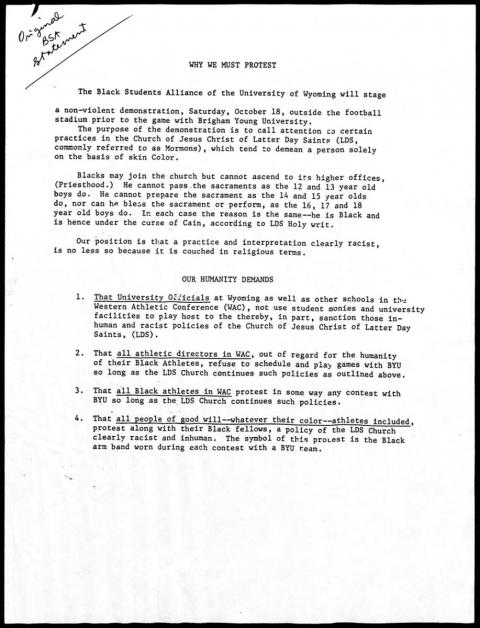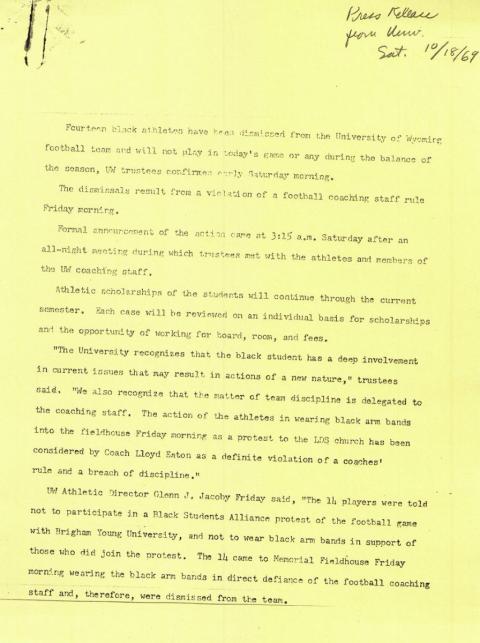Area 12: The U.S. During the Struggle for Civil Rights
Question: How successful was the U.S. in creating a more equitable society?
Background for teachers and students
In October 1969, the University of Wyoming Cowboys football team, ranked 12th in the nation, seemed headed for another championship season. But events just before Wyoming’s game against Brigham Young University brought bitter controversy that swung the national news spotlight onto the university and divided the state.
The 1960s saw Americans in frequent conflict over race, civil rights and the Vietnam War. In 1968, U.S. sprinters Tommie Smith and John Carlos linked sports to civil rights and sixties politics when, standing on the medalists’ platform at the Olympics, they raised black-gloved fists as loudspeakers played The Star-Spangled Banner. During that school year, some university athletes in the American West went public with their concerns about policies of The Church of Jesus Christ of Latter-day Saints (the Mormons) barring black men from the priesthood. The athletes protested and boycotted their teams’ games against BYU, which is owned and run by the Mormon Church.
In October 1969, UW graduate student Willie Black, chancellor of the university’s Black Student Alliance, learned about the Mormon policy. (The alliance was a chartered campus social organization of UW’s 50 or so African-American students at the time.) The Monday before the UW-BYU game, Black informed the alliance members about the Mormon policy.
On Wednesday, he presented a BSA statement “Why We Must Protest,” to UW’s president and athletic director, announcing plans for a non-violent demonstration at the stadium prior to the game. On Thursday, Head Coach Lloyd Eaton, then at the peak of a winning career, warned one of the team captains, Joe Williams, about the coach’s standing rule barring players from taking part in any demonstrations. Williams and the black players talked it over that night, and decided to go see the coach about it the next day.
Friday morning, 14 black UW football players showed up at Eaton’s office, wearing black armbands over their street clothes. Eaton led them into the field house, where he railed at them, according to the athletes’ later accounts, refused to discuss the matter and dismissed them all from the team.
After meeting most of the night, the UW trustees at 3:15 a.m. Saturday put out a statement dismissing the 14 from the team but allowing them to keep their scholarships through the end of the semester. On Saturday the Cowboys, without their black players, defeated BYU 40-7 in what Eaton called “the most satisfying [victory] I’ve ever had in coaching.” Undefeated at that point, UW won the next game but lost the last four of the season. National media covered the story; the university community and the state were deeply divided over the issue.
The National Association for the Advancement of Colored People filed suit in federal court against the State of Wyoming seeking reinstatement for the players and damages for violation of their civil rights. In 1971, the court ruled in favor of the state.
In 1970, meanwhile, the team went 1-9, its worst record in 30 years. After the season the trustees announced that Eaton would be moved to an administrative job in the athletic department. He left the university in 1971. The team continued to perform poorly through most of the 1970s.
In 1978, the leadership of the Mormon Church had a divine revelation and opened its priesthood to African Americans.
The selection linked below, “The Black 14: Race, Politics, Religion and Wyoming Football,” offers substantial background on the topic for teachers and for students 8th grade and up, and will be necessary for students to read before undertaking the exercises . The article may be demanding for 6th and 7th graders.
Read “The Black 14: Race, Politics, Religion and Wyoming Football”


